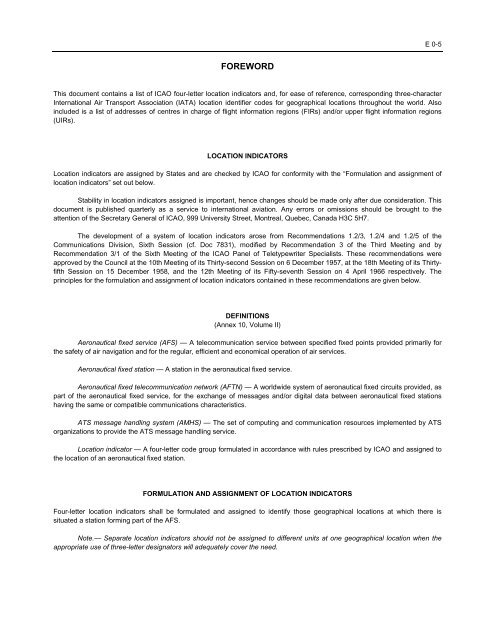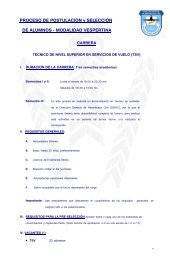LOCATION INDICATORS INDICATEURS D'EMPLACEMENT ...
LOCATION INDICATORS INDICATEURS D'EMPLACEMENT ...
LOCATION INDICATORS INDICATEURS D'EMPLACEMENT ...
Create successful ePaper yourself
Turn your PDF publications into a flip-book with our unique Google optimized e-Paper software.
FOREWORD<br />
E 0-5<br />
This document contains a list of ICAO four-letter location indicators and, for ease of reference, corresponding three-character<br />
International Air Transport Association (IATA) location identifier codes for geographical locations throughout the world. Also<br />
included is a list of addresses of centres in charge of flight information regions (FIRs) and/or upper flight information regions<br />
(UIRs).<br />
<strong>LOCATION</strong> <strong>INDICATORS</strong><br />
Location indicators are assigned by States and are checked by ICAO for conformity with the “Formulation and assignment of<br />
location indicators” set out below.<br />
Stability in location indicators assigned is important, hence changes should be made only after due consideration. This<br />
document is published quarterly as a service to international aviation. Any errors or omissions should be brought to the<br />
attention of the Secretary General of ICAO, 999 University Street, Montreal, Quebec, Canada H3C 5H7.<br />
The development of a system of location indicators arose from Recommendations 1.2/3, 1.2/4 and 1.2/5 of the<br />
Communications Division, Sixth Session (cf. Doc 7831), modified by Recommendation 3 of the Third Meeting and by<br />
Recommendation 3/1 of the Sixth Meeting of the ICAO Panel of Teletypewriter Specialists. These recommendations were<br />
approved by the Council at the 10th Meeting of its Thirty-second Session on 6 December 1957, at the 18th Meeting of its Thirtyfifth<br />
Session on 15 December 1958, and the 12th Meeting of its Fifty-seventh Session on 4 April 1966 respectively. The<br />
principles for the formulation and assignment of location indicators contained in these recommendations are given below.<br />
DEFINITIONS<br />
(Annex 10, Volume II)<br />
Aeronautical fixed service (AFS) — A telecommunication service between specified fixed points provided primarily for<br />
the safety of air navigation and for the regular, efficient and economical operation of air services.<br />
Aeronautical fixed station — A station in the aeronautical fixed service.<br />
Aeronautical fixed telecommunication network (AFTN) — A worldwide system of aeronautical fixed circuits provided, as<br />
part of the aeronautical fixed service, for the exchange of messages and/or digital data between aeronautical fixed stations<br />
having the same or compatible communications characteristics.<br />
ATS message handling system (AMHS) — The set of computing and communication resources implemented by ATS<br />
organizations to provide the ATS message handling service.<br />
Location indicator — A four-letter code group formulated in accordance with rules prescribed by ICAO and assigned to<br />
the location of an aeronautical fixed station.<br />
FORMULATION AND ASSIGNMENT OF <strong>LOCATION</strong> <strong>INDICATORS</strong><br />
Four-letter location indicators shall be formulated and assigned to identify those geographical locations at which there is<br />
situated a station forming part of the AFS.<br />
Note.— Separate location indicators should not be assigned to different units at one geographical location when the<br />
appropriate use of three-letter designators will adequately cover the need.





